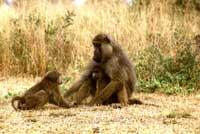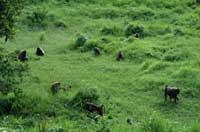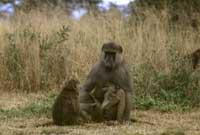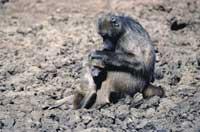Babuino knows how to distinguish his offspring

Beans are promiscuous, and both males and females have sex with several partners. Of course, the mother has no problem knowing her children, as they have brought them into the world. But males do not have such an easy task. The seeds, after “sowing” here and there, and considering that each female has received several seeds of males, all the offspring in the area can be yours or not. However, a group of researchers has made a surprising discovery. The Babuino have seen that they have the capacity to separate their offspring.
Researchers from Duke, UCLA and Princeton Universities have spent 30 years studying the behavior of baboons on the foothills of Mount Kilimanjaro in Kenya. In the last three years they have focused on contact between adults and young babuinos. Young Babuinos play with each other again and again and hostilities are frequent.
In these hostilities Babuinos make peace, but researchers have seen that they tend to defend what they consider their descendant. They protect the children of the house and drive away those who are not their own. The researchers have carried out DNA studies and have coincided with the selections made by the baboons. Baboons have the ability to know what their offspring are and what they are not.

The research has followed the displacements of 75 baboon pups and 15 adult male habuinos. The first work was to identify the parents of these babuino children. To do this, their excrement was collected and DNA analysis was performed. Then they began to observe the continuous disputes between the baboons.
Start playing and end up fighting. That's what happens to young babuinos. Do not measure the forces correctly and the game is the immediate struggle over the need to respond to every impulse, fight and bite received. Many of these clashes harden too much and often one of the adults has to participate to separate the young babuinos and make peace.
The eyes of the researchers are sharpened by the realization that the male baboon that begins to work in peace was the father of one of the rival puppies. Within three years there were 73 occasions in which the male baboon came to calm the battle in which his calf was found. But pacifist baboons are no example of neutrality, and scientists found that in 69 of those 73 clashes the baboon opted for its breeding. The researchers used DNA studies to clarify the family ties between the baboons, but how does the baboon itself know?
How do you know?

How do the baboon males manage to separate the offspring generated with their seed? Although it seems difficult to carry out, researchers consider that the male baboon takes into account which female and when she has covered it. But they are stricter than that. In fact, in the 4-5 days of greatest fertility the females babuino have inflated their sexual organs. During these days the female is more likely to become pregnant. Thus, if the female has been the only male who has had sex with the female during those days of inflating her sexual organs, or at least the one who has covered her most frequently, the male baboon may conclude that she will be the father of the new baby who will be born.
But the accounts do not always come out so clear, and although all indications point out that the paternity of the baby is very uncertain, the babuino manages to choose his puppy. Jason C. Zoologist Buchan and his colleagues believe that in these cases the baboon takes into account the characteristics of the puppy to decide whether it is theirs or not.
Common among human beings are attempts to find the child physical similarities with their parents, siblings or close relatives. That's what the baboon does. In addition to her physical characteristics, she also uses the smell to see if the baby looks like her and decide if she can consider her as her successor. And it gets good results.

Baboon, based on the memories of their sexual relationships and the characteristics and smells of the offspring, gets the same results as man through DNA studies. The worries of daily parenthood do not drown the male baboon, but when the young begin to fight and see that the health of their successor may be in danger, the baboon shows that he knows well those who are and are not of his blood. Babuino knows how to differentiate her offspring!
Published in 7K.
Buletina
Bidali zure helbide elektronikoa eta jaso asteroko buletina zure sarrera-ontzian











